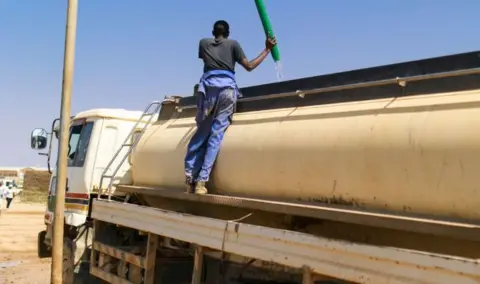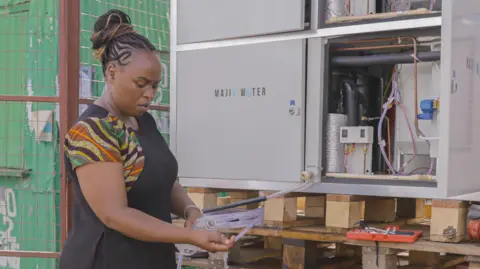When a severe drought hit the Indian city of Kozhikode, also known as Calicut, in 2016, residents including student Swapnil Shrivastav had access to a limited amount of water each day.
“We were rationed to two buckets of water a day, which we collected from water tanks,” he says.
While he says it’s not uncommon for water supply issues to impact parts of India, it was a tough month for Mr Shrivastav and others in the region. “It was a very humid area; it was unmanageable.”
Mr Shrivastav was already interested in water scarcity having won a student competition in 2012 on imagining the future of water in cities, but the experience pushed him to explore solutions.
“One element of inspiration was from Star Wars where there’s an air to water device. I thought why don’t we give it a try? It was more of a curiosity project.”
Several years later, in 2019, that idea led him, Govinda Balaji and Venkatesh Raja to set up Uravu Labs, a Bangalore-based startup.
Their system converts air to water using atmospheric water generators that contain a liquid desiccant, which absorbs moisture from the air.
Using sunlight or renewable electricity they heat the desiccant to 65C which releases the moisture, which can then be condensed into drinking water.
Mr Shrivastav says the whole process takes about 12 hours. Today each unit produces about 2,000 litres of drinking water.
However, while his vision was to supply drinking water to communities facing water shortages, he says it wasn’t financially viable.
“We realised the tech still needs more time to scale up and come down in cost,” says Mr Shrivastav. “Or someone should fund it, but we haven’t found the support in India.”
Instead, they currently sell the water to 40 clients in the hospitality industry, who in turn use it to provide drinking water for customers.
“We tried non-profit and CSR departments [corporate social responsibility]… but many companies shy away from tech. They thought it wouldn’t work. We had to shift to commercial consumption applications as they were ready to pay us and it’s a sustainability driver for them.”

Water shortages are not new, but many countries, especially in the global south, are experiencing climate change-related intense drought and flooding that contaminates water sources.
More than 50% of the global population – four billion people – experience water shortfalls at least once a month, while by 2025, 1.8 billion people are expected to be living in countries or regions with “absolute” water scarcity, according to the Food and Agriculture Organization of the United Nations.
Could atmospheric water generation technology be the answer? Energy efficient – it can be powered by renewable sources – it’s one way of providing a fresh source of water without the need for traditional water infrastructure, making it an attractive option in remote locations.
There appears to be a market for the technology. Valued at $3.4bn (£2.7bn) in 2022, the atmospheric water generation market is expected to be worth $13.5bn in 2032, according to a report by Global Market Insights.
There are two main methods for atmospheric water generation. Firstly, there’s the cooling and condensation process which cools humid air to its dew point, causing water vapour to condense into liquid water.
The second is a desiccant-based system which uses hygroscopic materials to absorb moisture from the air, then release it through a heating process, he says.

Through her social enterprise Majik Water, co-founder and chief executive Beth Koigi manages about 40 atmospheric water generator units across arid and semi-arid regions across Kenya, using a cooling and condensation-based techniques to capture moisture from the air.
Founded in 2017, Ms Koigi was inspired to start Majik Water after experiencing water scarcity for the first time during a drought when she was studying in Nairobi in 2016.
While many visited a nearby river to fetch water for cooking, drinking and washing, Koigi says she couldn’t bring herself to drink the contaminated water.
“It made me realise that you take for granted water as it’s always there.”
She started looking for other water source ideas and set up a water filter company before developing an air-to-water system.
Majik Water works with NGOs and humanitarian organisations, as well as being sold in stores.
Majik’s biggest unit produces 500 litres of water in 24 hours and is installed in schools and small communities.
While there is demand for her company’s system, Ms Koigi does not see it as a permanent solution.
“Honestly, I feel like this is not the solution to water scarcity,” says Ms Koigi. “It’s a temporary solution… mostly because it’s not cheap.”
Manufacturers are focused on making air-to-water generation systems more energy efficient, says Avinash Singh, associate director of research and consulting at Global Market Insights.
“For instance, innovations in compressors, heat exchangers, and desiccants have improved the energy efficiency of such systems.”
He adds that government support, subsidies, or environmental regulations could drive further adoption of the technology.
One development which has helped the adoption of such water systems is the move to digital payments.
Headquartered in Italy, Veragon has water production units across the Middle East, Asia, Africa, and South America.
“When we originally started with off-grid communities, it was a cash-based society which wasn’t really viable… nowadays it’s being digitalised,” says Veragon global business director Stephen White.
“For example, the majority of Cambodia is covered by 4G and Covid saw an explosion of e-wallets. There’s much better private infrastructure and partnership – the government doesn’t have to be involved, and we sell water at much lower price.”
He says all units will be moved to digital in the next few months.
However, the prices of the units is not cheap. Veragon says its units, which use the cooling and condensing system, cost between $60,000 and $70,000.
But Mr Shrivastav points that making water in situ has a cost advantage as water is quite heavy and not easy to transport around.
Looking ahead, Uravu Labs is exploring how advancements in material science can improve the efficiency of desiccants, or how utilising a different material for absorbing more moisture from the air could make the process more effective. Mr Shrivastav says these advancements will also result in reducing the heat required from 60C to 40C.
They are also hoping to run pilot projects involving installing its units in data centres in India and Singapore.
Data centres generate a lot of heat which is usually lost, but Uravu plans to instead to use it create fresh water.
“This process will result in up to 95% reduction in fresh water consumption [by the datacentre] as Uravu’s system captures most of the waste heat and gives back cold water, thus very little freshwater is needed as a top-up,” says Mr Shrivastav.









